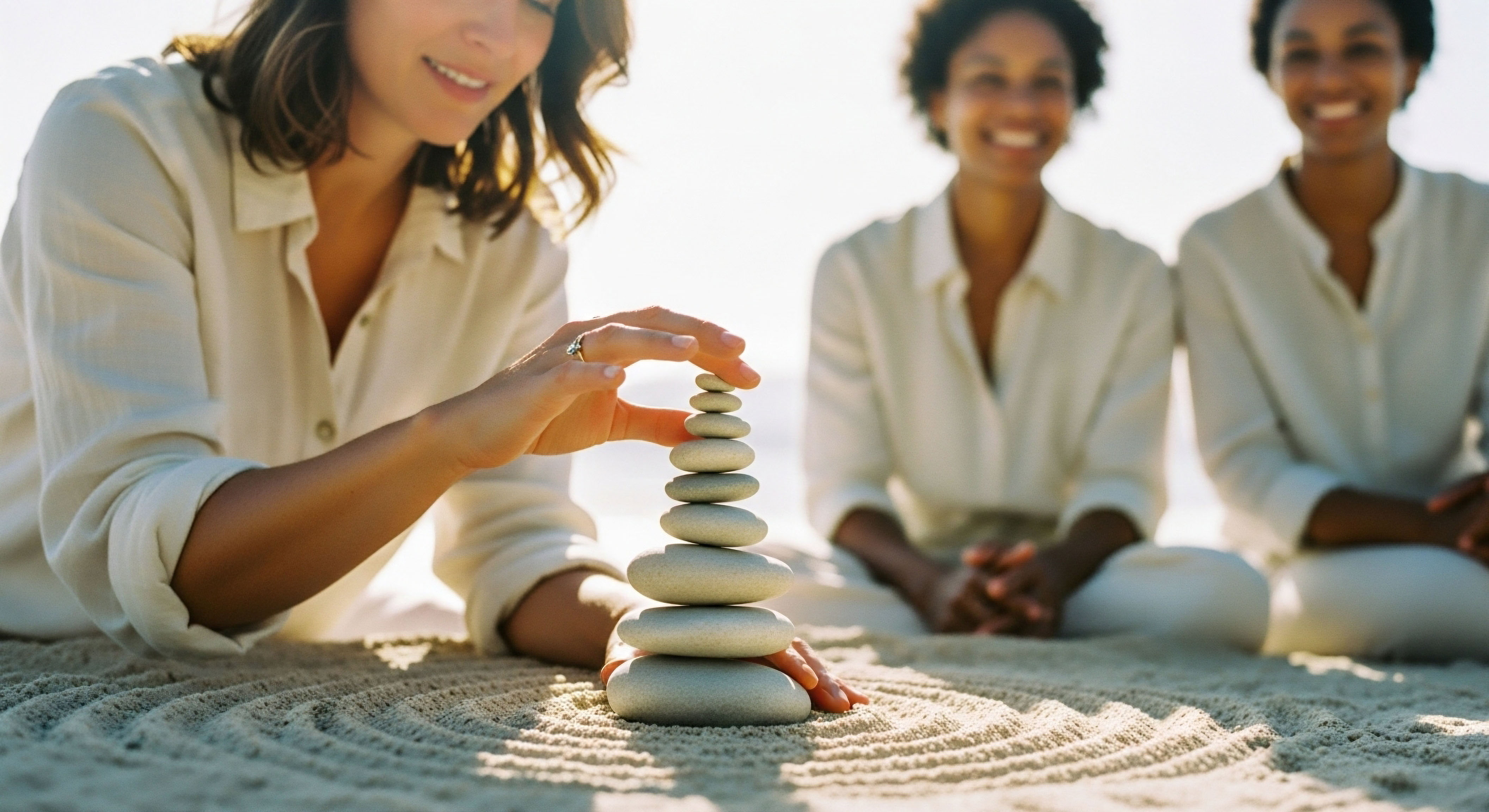

Fundamentals
Many individuals experience a subtle, yet persistent, shift in their overall vitality as the years progress. This often manifests as a diminished drive, a lingering sense of fatigue, or a quiet erosion of the physical and mental sharpness once taken for granted.
For men, these changes frequently touch upon areas of sexual health, leading to questions about what might be occurring within their biological systems. The experience can feel isolating, yet it is a widely shared human reality, prompting a search for understanding and effective strategies to restore a sense of well-being.
Understanding these shifts begins with recognizing the intricate network of chemical messengers that orchestrate our bodily functions. These messengers, known as hormones, regulate everything from mood and energy levels to muscle mass and sexual function. When these systems fall out of optimal alignment, the effects can ripple across multiple aspects of daily life, impacting not only physical capabilities but also emotional resilience and cognitive clarity.
A decline in vitality and sexual health often signals a need to investigate the body’s internal chemical messaging systems.
The body’s internal communication system relies on a complex interplay of signals. One central command center is the hypothalamic-pituitary-gonadal axis, or HPG axis. This biological pathway involves the hypothalamus in the brain, which sends signals to the pituitary gland, also in the brain. The pituitary then communicates with the gonads ∞ the testes in men ∞ to regulate the production of key hormones, such as testosterone. When this axis functions optimally, it supports robust hormonal balance.
Peptides, small chains of amino acids, represent another vital class of signaling molecules within the body. They act as specific messengers, instructing cells and tissues to perform particular actions. Unlike larger proteins, peptides are relatively small, allowing them to interact with specific receptors and initiate targeted biological responses. Their role in the body is diverse, ranging from regulating appetite and sleep to influencing growth and repair processes.

What Are Peptides and How Do They Influence Male Physiology?
Peptides are essentially the body’s natural communicators, providing precise instructions at a cellular level. Consider them as highly specialized keys designed to fit very specific locks on cell surfaces. When a peptide binds to its corresponding receptor, it triggers a cascade of events within the cell, leading to a desired physiological outcome. This specificity is a defining characteristic of peptide action, allowing for targeted interventions in various biological pathways.
In the context of male physiology, certain peptides play direct roles in regulating hormonal output, tissue repair, and even neurological processes that influence sexual function. For instance, some peptides can stimulate the release of growth hormone, which indirectly supports overall metabolic health and tissue integrity, both of which are foundational to sexual well-being. Other peptides can directly influence the production or release of sex hormones or improve blood flow to specific tissues.

The Endocrine System and Its Interconnectedness
The endocrine system, a collection of glands that produce and secrete hormones, operates as a finely tuned orchestra. No single hormone or gland functions in isolation. Testosterone, for example, does not simply exist as an independent entity; its production and activity are influenced by signals from the brain, the health of the testes, and the balance of other hormones, including estrogen and cortisol. A disruption in one area can create a ripple effect throughout the entire system.
When considering male sexual health, it is important to look beyond just testosterone levels. Factors such as metabolic health, cardiovascular function, sleep quality, and stress management all contribute to the overall hormonal landscape. Peptides offer a unique avenue for intervention because they can target specific pathways within this interconnected system, aiming to restore balance and improve function without broadly overriding natural regulatory mechanisms. This systems-based approach recognizes that true vitality stems from the harmonious operation of all bodily processes.


Intermediate
As we move beyond the foundational understanding of hormones and peptides, a deeper exploration of specific clinical protocols reveals how these signaling molecules can be strategically applied to support male sexual health. The aim is to recalibrate the body’s internal systems, addressing underlying imbalances rather than simply masking symptoms. This involves a careful consideration of how various therapeutic agents interact with the body’s complex feedback loops.
One common concern for men is a decline in testosterone levels, often termed andropause or late-onset hypogonadism. While traditional testosterone replacement therapy (TRT) directly supplements this hormone, certain peptides offer an alternative or complementary strategy by stimulating the body’s own production. This approach seeks to maintain the natural physiological rhythm of hormone synthesis, which can be particularly relevant for men concerned about fertility or long-term testicular function.

Targeted Peptide Applications for Male Sexual Health
Peptides are increasingly recognized for their precise actions, allowing for highly targeted interventions. In the context of male sexual health, several peptides have garnered attention for their potential to influence hormonal balance, improve erectile function, and support overall well-being. Their mechanisms often involve stimulating natural pathways or modulating specific physiological responses.

Growth Hormone Secretagogues and Endocrine Support
A class of peptides known as growth hormone secretagogues (GHS) stimulates the pituitary gland to release more growth hormone (GH). While not directly sex hormones, GH plays a crucial role in metabolic function, body composition, and tissue repair, all of which indirectly support sexual health. Improved metabolic health can enhance energy levels and reduce systemic inflammation, both beneficial for erectile function and libido.
- Sermorelin ∞ This peptide mimics growth hormone-releasing hormone (GHRH), prompting the pituitary to secrete GH in a pulsatile, physiological manner. Its action is considered more natural than direct GH administration, as it works with the body’s own regulatory mechanisms.
- Ipamorelin / CJC-1295 ∞ This combination offers a sustained release of GH. Ipamorelin is a selective GH secretagogue, while CJC-1295 (without DAC) is a GHRH analog that extends the half-life of Ipamorelin’s action. This pairing can lead to more consistent GH elevation, supporting muscle mass, fat reduction, and sleep quality, all factors contributing to vitality.
- Tesamorelin ∞ Specifically approved for reducing visceral fat in certain conditions, Tesamorelin is another GHRH analog. Its metabolic benefits can indirectly support cardiovascular health, which is closely linked to erectile function.
These peptides are typically administered via subcutaneous injections, often two to three times per week, to mimic the body’s natural pulsatile release of growth hormone. The precise dosing and frequency are tailored to individual needs and responses, guided by clinical assessment and laboratory monitoring.
Peptides can stimulate the body’s own hormone production, offering a nuanced approach to restoring physiological balance.

Peptides Directly Influencing Sexual Function
Beyond general endocrine support, specific peptides directly address aspects of male sexual function. These agents often work by modulating neurotransmitter systems or influencing blood flow dynamics, which are critical for erectile response.
PT-141, also known as Bremelanotide, is a peptide that acts on melanocortin receptors in the brain. Its mechanism of action is distinct from traditional erectile dysfunction medications, which primarily affect blood flow. PT-141 works centrally, influencing neural pathways involved in sexual arousal and desire.
This makes it a unique option for individuals who may not respond to conventional treatments or whose concerns extend beyond purely physical erectile capacity to include issues of libido and sexual interest. It is typically administered as a subcutaneous injection prior to sexual activity.
Another peptide, Gonadorelin, is a synthetic form of gonadotropin-releasing hormone (GnRH). It stimulates the pituitary gland to release luteinizing hormone (LH) and follicle-stimulating hormone (FSH). In men, LH stimulates the testes to produce testosterone, while FSH is important for sperm production.
Gonadorelin is often used in men undergoing testosterone replacement therapy to help maintain testicular size and function, and to preserve fertility, by preventing the suppression of natural testosterone production that can occur with exogenous testosterone administration. It is commonly administered via subcutaneous injections, often twice weekly.

Comparing Therapeutic Approaches for Male Hormonal Balance
The choice of therapeutic approach depends on individual circumstances, symptoms, and treatment goals. A comparative understanding of different protocols helps in making informed decisions.
| Therapy Type | Primary Mechanism | Key Benefits for Male Sexual Health | Considerations |
|---|---|---|---|
| Testosterone Replacement Therapy (TRT) | Direct exogenous testosterone administration | Directly raises testosterone levels, improving libido, energy, muscle mass | Can suppress natural testosterone production and fertility; requires careful management of estrogen conversion. |
| Growth Hormone Secretagogue Peptides (e.g. Sermorelin, Ipamorelin) | Stimulates endogenous growth hormone release | Improves body composition, energy, sleep; indirect support for vitality and sexual function | Indirect effects on sexual health; benefits accrue over time. |
| Gonadorelin | Stimulates LH and FSH release from pituitary | Maintains testicular function and fertility during TRT; supports natural testosterone production | Primarily a supportive therapy; does not directly replace testosterone. |
| PT-141 (Bremelanotide) | Acts on central melanocortin receptors | Enhances sexual arousal and desire; addresses libido issues | Central action, distinct from blood flow mechanisms; requires specific timing. |
When men discontinue TRT or are actively trying to conceive, a specific protocol involving agents like Gonadorelin, Tamoxifen, and Clomid is often employed. Tamoxifen and Clomid (clomiphene citrate) are selective estrogen receptor modulators (SERMs) that block estrogen’s negative feedback on the pituitary, thereby increasing LH and FSH release and stimulating endogenous testosterone production. This strategy aims to reactivate the HPG axis and restore natural hormonal function after exogenous testosterone has been withdrawn.
The application of these peptides and protocols requires a precise understanding of their pharmacodynamics and a commitment to ongoing monitoring. This ensures that the interventions are not only effective but also aligned with the individual’s broader health objectives, promoting a sustainable path toward enhanced well-being.


Academic
A deep examination of peptide applications in male sexual health necessitates a rigorous exploration of underlying endocrinology and systems biology. The human body operates as an integrated network, where hormonal signals, metabolic pathways, and neurological circuits are inextricably linked. Understanding these connections provides a more complete picture of how specific peptide interventions can influence overall physiological function and, by extension, male sexual vitality.
The complexity of the hypothalamic-pituitary-gonadal (HPG) axis extends beyond simple feedback loops. It is a dynamic regulatory system, constantly adjusting hormone production based on internal and external cues. Gonadotropin-releasing hormone (GnRH), secreted by the hypothalamus, acts on the pituitary to release luteinizing hormone (LH) and follicle-stimulating hormone (FSH).
LH then stimulates Leydig cells in the testes to produce testosterone, while FSH supports spermatogenesis within the seminiferous tubules. This intricate cascade ensures precise control over male reproductive and endocrine function.

Mechanistic Insights into Peptide Action on the HPG Axis
Peptides like Gonadorelin offer a direct means to modulate the HPG axis. As a synthetic GnRH analog, Gonadorelin binds to GnRH receptors on pituitary gonadotrophs, mimicking the natural pulsatile release of GnRH. This stimulation leads to a subsequent release of LH and FSH.
The pulsatile nature of GnRH signaling is critical; continuous exposure to GnRH can paradoxically desensitize pituitary receptors, leading to a downregulation of LH and FSH. This is why Gonadorelin is typically administered in a pulsatile fashion, often via subcutaneous injections two to three times per week, to maintain physiological responsiveness.
The clinical application of Gonadorelin is particularly relevant in men undergoing exogenous testosterone therapy. While TRT effectively raises circulating testosterone levels, it can suppress endogenous GnRH, LH, and FSH production through negative feedback, leading to testicular atrophy and impaired spermatogenesis.
Gonadorelin helps to counteract this suppression by providing the necessary pulsatile stimulation to the pituitary, thereby preserving testicular function and supporting fertility. Research indicates that concurrent Gonadorelin administration with TRT can mitigate the decline in intratesticular testosterone and maintain sperm parameters, a significant consideration for younger men or those desiring future fertility.

The Role of Melanocortin Receptors in Sexual Arousal
The peptide PT-141 (Bremelanotide) represents a fascinating avenue for addressing sexual dysfunction, particularly concerning desire and arousal. Its mechanism of action involves the activation of melanocortin receptors, specifically MC3R and MC4R, within the central nervous system. These receptors are widely distributed in brain regions associated with sexual function, including the hypothalamus and preoptic area. Activation of these receptors is thought to modulate neural pathways involved in sexual motivation and response, leading to increased arousal and desire.
Unlike phosphodiesterase-5 (PDE5) inhibitors, which primarily enhance the erectile response by increasing nitric oxide-mediated vasodilation in the penile tissue, PT-141 acts upstream, influencing the neurochemical signals that initiate the sexual response. This central mechanism explains why PT-141 can be effective in individuals who experience low libido or arousal despite adequate erectile function, or those who do not respond to PDE5 inhibitors.
Clinical trials have demonstrated its efficacy in improving sexual desire and satisfaction in both men and women with sexual dysfunction, highlighting its distinct pharmacological profile.
Peptides can influence sexual health by modulating central nervous system pathways and preserving natural hormonal feedback loops.

Growth Hormone Secretagogues and Metabolic Interplay
While not directly impacting sex hormone production, growth hormone secretagogue peptides (GHS) exert profound effects on metabolic health, which is intimately linked to male sexual function. Peptides such as Sermorelin and Ipamorelin/CJC-1295 stimulate the pulsatile release of endogenous growth hormone (GH) from the pituitary. GH, in turn, influences insulin-like growth factor 1 (IGF-1) production in the liver and other tissues. The GH/IGF-1 axis plays a critical role in protein synthesis, lipolysis, and glucose metabolism.
Improved body composition, characterized by reduced visceral adiposity and increased lean muscle mass, is a direct benefit of optimized GH levels. Visceral fat is metabolically active and can contribute to systemic inflammation and insulin resistance, both of which negatively impact endothelial function and testosterone levels.
By promoting a healthier metabolic profile, GHS peptides can indirectly support cardiovascular health, which is a prerequisite for robust erectile function. Furthermore, enhanced energy levels and improved sleep quality, often reported with GHS therapy, contribute to overall vitality and sexual well-being.

The Interplay of Hormones and Metabolic Markers
The relationship between hormonal status and metabolic markers is bidirectional. For instance, low testosterone is frequently associated with metabolic syndrome, insulin resistance, and increased cardiovascular risk. Conversely, conditions like obesity and type 2 diabetes can depress testosterone levels. This complex interplay underscores the importance of a holistic approach to male sexual health.
| Hormone/Peptide | Primary Action | Impact on Metabolic Markers | Relevance to Male Sexual Health |
|---|---|---|---|
| Testosterone | Androgenic and anabolic effects | Influences insulin sensitivity, body fat distribution, muscle mass | Directly impacts libido, erectile function, energy, mood. |
| Growth Hormone (GH) | Promotes tissue growth, protein synthesis, lipolysis | Reduces visceral fat, improves glucose metabolism, increases lean mass | Indirectly supports erectile function via cardiovascular health; enhances energy and vitality. |
| Gonadorelin | Stimulates LH/FSH release | Maintains testicular function, indirectly supports metabolic health via endogenous testosterone | Preserves fertility and natural testosterone production, mitigating TRT side effects. |
| PT-141 | Activates central melanocortin receptors | No direct metabolic impact | Addresses central aspects of sexual arousal and desire, distinct from physical erectile capacity. |
The application of peptides in male sexual health is not a simplistic endeavor. It requires a comprehensive understanding of endocrinology, metabolic physiology, and the nuanced interactions within the body’s systems. By targeting specific pathways, these agents offer precise tools to restore balance, enhance function, and ultimately support a man’s overall vitality and well-being. The ongoing research in this field continues to refine our understanding and expand the therapeutic possibilities for personalized wellness protocols.

References
- Müller, E. E. & Parenti, M. (2000). Growth Hormone Secretagogues. Springer.
- Bhasin, S. & Bremner, W. J. (2016). Clinical Management of Male Hypogonadism. Springer.
- Rosen, R. C. & Goldstein, I. (2012). Erectile Dysfunction ∞ Pathophysiology and Treatment. Informa Healthcare.
- Shabsigh, R. et al. (2009). Bremelanotide for the treatment of hypoactive sexual desire disorder in women ∞ a randomized, placebo-controlled trial. Journal of Sexual Medicine, 6(11), 3073-3081.
- Kaufman, J. M. & Vermeulen, A. (2005). The decline of androgen levels in aging men and its clinical and therapeutic implications. Endocrine Reviews, 26(6), 833-876.
- Nieschlag, E. & Behre, H. M. (2012). Testosterone ∞ Action, Deficiency, Substitution. Cambridge University Press.
- Veldhuis, J. D. et al. (2006). Physiological regulation of the somatotropic axis in men ∞ pulsatile secretion of growth hormone and its modulation by age, sex, and body composition. Endocrine Reviews, 27(7), 711-750.
- Swerdloff, R. S. & Wang, C. (2018). Androgens and the Aging Male. Academic Press.

Reflection
Considering the intricate dance of hormones and the precise actions of peptides, it becomes clear that understanding your own biological systems is a powerful step toward reclaiming vitality. This knowledge is not merely academic; it is a personal compass, guiding you through the often-complex terrain of health and well-being. Each individual’s biological blueprint is unique, and so too should be the approach to optimizing health.
The journey toward improved hormonal health and sexual function is deeply personal, requiring careful consideration and a partnership with knowledgeable professionals. The insights shared here serve as a foundation, a starting point for deeper conversations about your specific needs and aspirations. Moving forward, the opportunity lies in translating this scientific understanding into actionable strategies tailored to your unique physiology, paving the way for a renewed sense of function and overall wellness.



